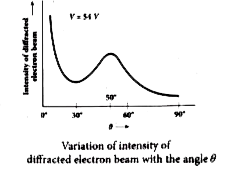Describe briefly Davisson - Germer experiment which demonstrated the wave nature of electrons.Solution in Tamil
Davisson - Germer experiment :
(i) De Broglie hypothesis of matter waves was experimentally confirmed by Clinton Davisson and Lester Germer. (ii) They demonstrated that electron beams are diffracted when they fall on crystalline solids. Since crystal can act as a three dimensional diffraction grating for matter waves, the electron waves incident on crystals are diffracted off in certain specific directions.
(iii) The filament F is heated by a low tension (L.T.) battery. Electrons are emitted from the hot filament by thermionic emission. (iv) They are then accelerated due to the potential difference between the filament and the anode aluminium cylinder by a high tension (H.T.) battery. (v) Electron beam is collimated by using two thin aluminium diaphragms and is allowed to strike a single crystal of Nickel. (vi) The electrons scattered by Ni atoms in different directions are received by the electron detector which measures the intensity of scattered electron beam.
(vii) The detector is rotatable in the plane of the paper so that the angle ϕ between the incident beam and the scattered beam can be changed at our will. The intensity of the scattered electron beam is measured as a function of the angle θ.

(viii) Figure shows the variation of intensity of the scattered electrons with the angle θ for the accelerating voltage of 54V. For a given accelerating voltage V, the scattered wave shows a peak or maximum at an angle of 50∘ to the incident electron beam.
(ix) This peak in intensity is attributed to the constructive interference of electrons diffracted from various atomic layers of the target material.
(x) From the known value of interplanar spacing of Nickel, the wavelength of the electron wave has been experimentally calculated as 1.65 Å.
(xi) The wavelength can also be calculated from de Broglie relation for V = 54 V from equation as
λ=12.27√VÅ=12.27√54
λ=1.67Å
(xii) This value agrees well with the experimentally observed wavelengti of 1.65Å. Thus this experiment directly verifies de Broglie.s hypothesis of the wave nature of moving particles.
Similar Questions
Discuss the Davisson and Germer experiment.
05:12View SolutionDescribe briefly Davisson - Germer experiment which demonstrated the wave nature of electrons.
10:08View SolutionWave Nature of Matter|Davisson And Germer Experiment
43:12View SolutionStatement-1: Davisson-Germer experiment established the wave nature of electron
Statement-2: If electrons have wave nature, they can interfere show differaction.03:06View Solution(A): Davisson - Germer experiment established the wave nature of electrons.
(R): If electrons have wave nature, they can interfere and show diffraction.View SolutionDescribe Davisson and Germer experiment to explain the wave nature of electron.
06:52View SolutionDraw a neat labelled diagram of Davisson and Germer experiment for diffraction of electron wave.
04:52View SolutionThe Davisson-Germer experiments that first demonstrated the wave nature of matter used electron accelerated to 54eV . The wavelength (in A^o ) of the electrons in the Davisson-Germer experiment is
02:14View Solution

